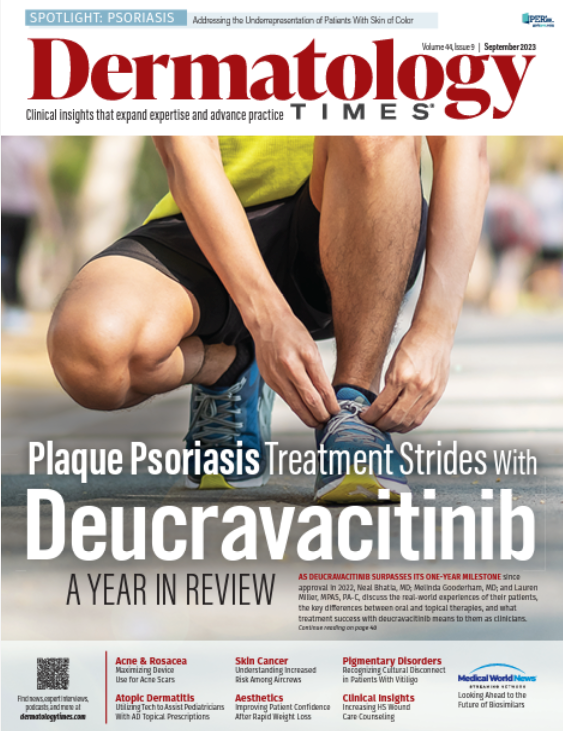- Case-Based Roundtable
- General Dermatology
- Eczema
- Chronic Hand Eczema
- Alopecia
- Aesthetics
- Vitiligo
- COVID-19
- Actinic Keratosis
- Precision Medicine and Biologics
- Rare Disease
- Wound Care
- Rosacea
- Psoriasis
- Psoriatic Arthritis
- Atopic Dermatitis
- Melasma
- NP and PA
- Skin Cancer
- Hidradenitis Suppurativa
- Drug Watch
- Pigmentary Disorders
- Acne
- Pediatric Dermatology
- Practice Management
- Prurigo Nodularis
- Buy-and-Bill
Publication
Article
Dermatology Times
VISIBLE Study Paves Way for More Equitable Psoriasis Research
Author(s):
The study is the only large-scale dermatologic study to prospectively generate insights into skin conditions among patients of racial and ethnic minority groups.
Despite extensive studies and an ever-expanding treatment landscape in psoriasis, there is a significant gap in research related to the impact and manifestations of the condition in patients with skin of color who belong to racial or ethnic minority groups. Through exploring the distinct clinical presentations, impacts on quality of life, disparities in health care, and cultural stigmatization experienced by this patient population, Janssen’s VISIBLE study (NCT05272150)1 serves as a call to action for dermatology providers and investigators to continue to bridge these gaps in research and care.
The phase 3b, double-blind, multicenter, placebo-controlled, randomized clinical study is the first of its kind and the only large-scale demographic study to prospectively generate insights into skin conditions among patients of racial and ethnic minority groups.
The study also seeks to evaluate the safety and efficacy of guselkumab (Tremfya) compared to a placebo in patients with skin of color who present with a moderate to severe plaque or scalp psoriasis diagnosis. Participants self-identified as either non-white or non-Caucasian and have had a psoriasis diagnosis for at least 6 months prior to treatment initiation.
Janssen announced initiation of the groundbreaking study in March 20222 as one of several components of the company’s commitment known as ORTHE, or Our Race to Health Equity. According to Janssen, while guselkumab has a well-established profile of efficacy and safety in psoriasis treatment, there are limited data on the use of the drug in patients of minority populations. In fact, within the previous 2 decades, 86% of phase 3 clinical trials investigating psoriasis treatments have included a majority of white participants.2
Andrew Alexis, MD, MPH, is a professor of clinical dermatology and vicechair for diversity and inclusion at Weill Cornell Medicine in New York, New York, and the study’s lead investigator. Alexis is also president of the Skin of Color Society and director of the first-of-its-kind Skin of Color Center at Weill Cornell Medicine. According to Alexis, VISIBLE is poised to shed light on several relevant clinical questions related to treating the condition in diverse patient populations.
“In addition to common assessments of disease severity such as PASI [Psoriasis Area and Severity Index] and IGA [Investigator’s Global Assessment], the study includes novel secondary endpoints that are particularly relevant to patients with skin of color, such as the assessment of pigmentary alterations associated with psoriasis,” he said. “For the first time, we can evaluate the safety and efficacy of a biologic treatment for psoriasis in a patient population that has historically been underrepresented in clinical trials of psoriasis.”
The study has not been without challenges.
“Some of the challenges faced by a study like VISIBLE include the nuances of performing investigator assessments such as PASI and IGA in patients with richly pigmented skin, among whom rating of erythema can be more challenging due to the optical effects of increased melanin pigment. This challenge was overcome by robust investigator training modules and use of confirmatory review of photographs with both standard and polarized lighting,” Alexis said. “Another challenge overcome by the VISIBLE study was the enrollment of patient populations that have historically faced access barriers to clinical trials. This was addressed by broadening the range of study sites and investigators to ensure geographic and demographic diversity.”
Alexis is hopeful the study will improve dermatology providers’ understandings of identifying psoriasis in darker skin types.
“The VISIBLE study will broaden our understanding of the range of clinical features (at baseline and over the course of treatment) in patients with skin of color,” he said. “This in turn will help to improve the quality of care we provide to our patients.”
Disclosure: Andrew Alexis, MD, MPH, is a paid consultant for Janssen.
References
1. Study of guselkumab in skin of color participants with moderate-to-severe plaque and/or scalp psoriasis (VISIBLE). ClinicalTrials.gov. Updated August 16, 2023. Accessed August 10, 2023. https://clinicaltrials.gov/study/NCT05272150?term=NCT05272150&rank=1
2. Janssen initiates first-of-its-kind clinical study to bridge critical gaps in care for people of color with moderate to severe plaque psoriasis. News release. Johnson & Johnson. March 22, 2022. Accessed August 10, 2023. https://www.jnj.com/janssen-initiates-first-of-its-kind-clinical-study-to-bridge-critical-gaps-in-care-for-people-of-color-with-moderate-to-severe-plaque-psoriasis







